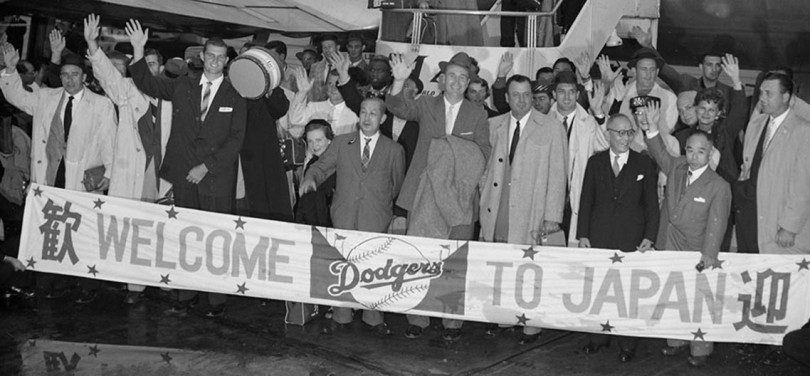
international relations
By Mark Langill
Brooklyn Dodgers - 1956 Japan Tour
The worlds of both the Brooklyn Dodgers and Japan’s professional baseball leagues were ushered into new eras at the beginning of the 1950s.
When Walter O’Malley became president of the National League powerhouse in 1950, his global view would become a trademark of the Dodger franchise over the next two decades as the New York native oversaw many historical changes, both within the United States and across the Pacific Rim as the sport grew in popularity following World War II.
Matsutaro Shoriki, the founder of the Tokyo Yomiuri Giants, publisher of the Yomiuri Shimbun and “father of professional baseball in Japan” dispatched renowned sports columnist Sotaro Suzuki to New York to meet with O’Malley and ask the Dodgers to make a trip to Japan. Acting on Shoriki’s orders, Suzuki’s contributions to the Japanese-American goodwill tours while working for the Yomiuri Shimbun set the stage for the newspaper’s invitation to the 1956 Brooklyn Dodgers to play in a 20-game exhibition schedule from October 19 to November 16.
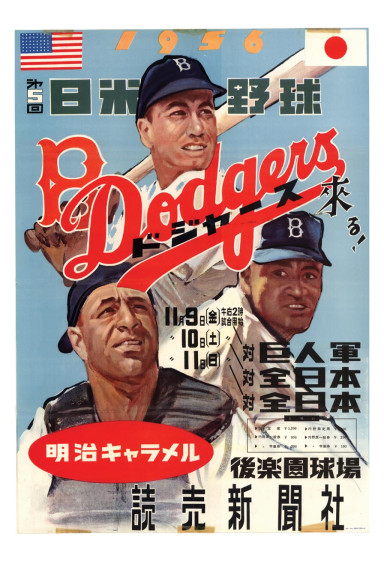
This rare promotional poster welcomes the 1956 National League Champion Brooklyn Dodgers on their first Goodwill Tour to Japan, with images of (left-right) future Dodger Hall of Famers Roy Campanella and Duke Snider, along with star pitcher Don Newcombe. The flags representing the United States and Japan top the poster, along with information about the games. In one month, the Dodgers played a total of 19 games.
Suzuki is best remembered as the man who helped convince Babe Ruth to tour Japan in 1934, an event that would trigger the start of professional baseball in Japan. According to legend, Suzuki tracked down Ruth at a barbershop in New York and stressed how popular he was in Japan, showing a planned Japanese tour poster in which Ruth was the only player pictured.
Suzuki, educated in Japan and partially at Columbia University in New York, joined the Yomiuri newspaper in the early 1930s and later served as a liaison for the Japanese Commissioner’s Office.
The Dodgers were the fifth American major league team invited by the Yomiuri newspaper. The first major league team invited was an all-star team in 1931. The second was another all-star ensemble in 1934, which featured Hall of Famers Ruth, Lou Gehrig, Jimmie Foxx and Lefty Grove.
The success of Lefty O’Doul’s tour of Japan with his 1950 San Francisco Seals minor league team led to major league invitations for the Eddie Lopat All-Stars and the New York Giants in 1953 and the New York Yankees in 1955.
The Brooklyn Dodgers were at the height of their popularity, having captured their first championship in 1955 with a dramatic seven-game World Series classic against their October rivals, the New York Yankees.
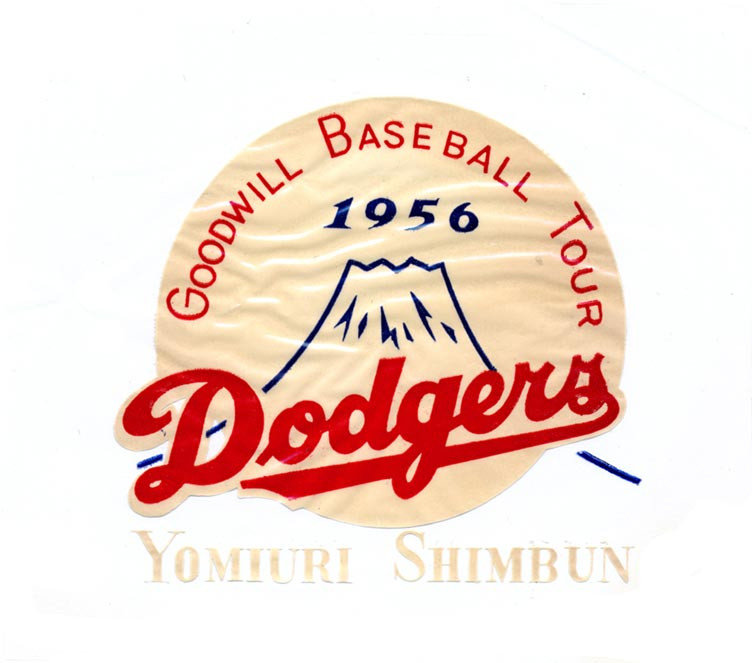
This unique cellophane decal is from the 1956 Dodgers Goodwill Tour to Japan showing Mt. Fuji as the centerpiece and the Dodger logo shown in red. The tour was sponsored by the Yomiuri Shimbun.
Early in 1956, Suzuki began corresponding with O’Malley on behalf of Shoriki, Minister of State in the Hatoyama Cabinet and owner-publisher of the Yomiuri newspaper. Shoriki, who also founded the Nippon Television Network, sent a letter to O’Malley on Feb. 9, 1956 that outlined his All-Star tour invitation and gave Suzuki authorization and power of attorney to negotiate on behalf of the Yomiuri newspaper.
In a letter to Suzuki on April 30, 1956, O’Malley said it seemed appropriate the reigning World Champions visit Japan and he was pleased to receive the support from Ambassador Toshikazu Kase, representing the Office of the Permanent Observer of Japan to the United Nations, along with Baseball Commissioner Ford C. Frick. He also hoped to publicize the trip in August.
“This general proposal has my personal support and I wish to thank you for the honor which you have done our players by inviting them to make this trip,” O’Malley wrote, “and for the patience you have shown in waiting for me to discuss this invitation with the individual players.”
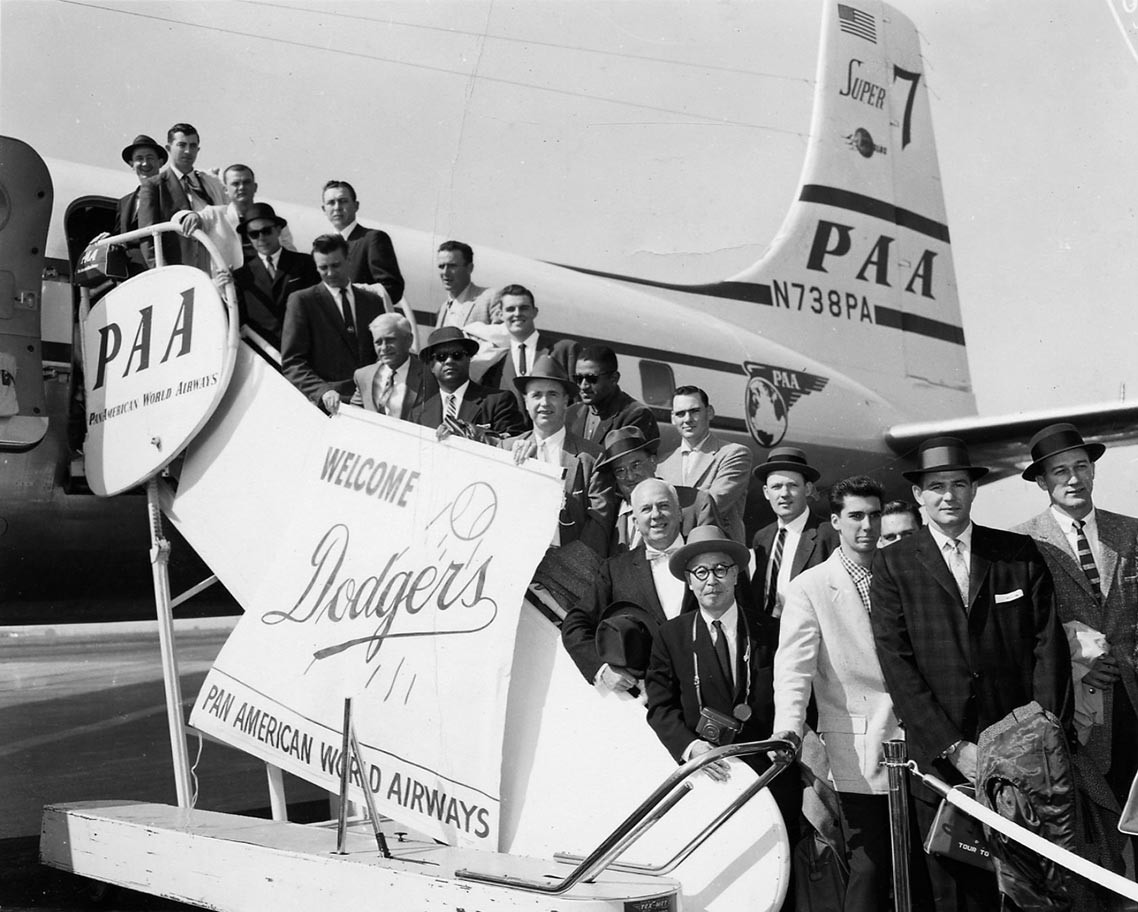
The National League Champion Dodger contingent is prepared for departure for their 1956 Goodwill Tour to Japan. The team boards Pan American Airways en route to Hawaii for exhibition games; an unexpected stopover at Wake Island due to a mechanical issue; and then on to Tokyo to begin the 19-game tour.
The Dodgers defended their National League crown in 1956, but it wasn’t easy. It took a victory over the Pittsburgh Pirates on the final day of the regular season to clinch the title with a 93-61 record, one game ahead of the Milwaukee Braves. Duke Snider led the league with a career-high 43 home runs and pitcher Don Newcombe (27-7) became the first player in history to win both the Cy Young and Most Valuable Player Awards in the same season.
The Dodgers and Yankees staged another seven-game classic, but with different results. While Brooklyn lost its first two road games in 1955 on its way to the championship, the Dodgers wasted a 2-0 Series lead in 1956 as the Yankees posted three consecutive victories, including Don Larsen’s perfect game at Yankee Stadium in Game 5. The Dodgers won Game 6 behind Clem Labine’s 10-inning shutout, but dropped the deciding Game 7 at Ebbets Field, 9-0.
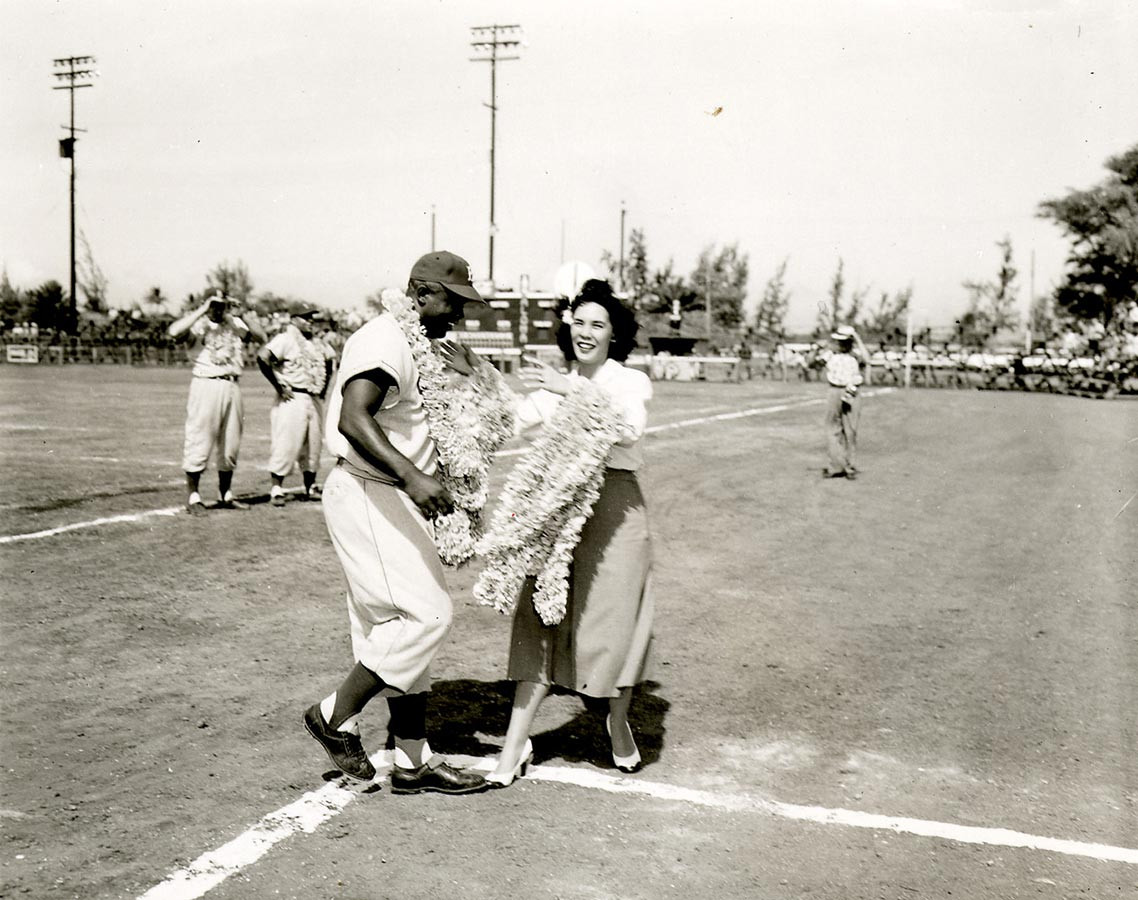
Jackie Robinson received a flower lei during an exhibition game in Hawaii.
The pre-tour exhibitions in Hawaii may have been planned as a chance to keep sharp had the Dodgers’ season ended in late September, but the Brooklyn players likely could have used the rest.
Hours after their World Series defeat, the Dodgers left New York on October 11 on United Airlines Dodger Special Flight 2709 (Douglas DC-7) from Idlewild Airport at 12:30 p.m. They arrived in Los Angeles International Airport at 5:05 p.m. and took limousines to the Statler Hotel. The party flew to Hawaii on October 12 to begin a five-day stay that included goodwill visits, sightseeing and exhibition games against the Maui All-Stars, the Hawaiian All-Stars and the Hawaiian champion Red Sox.
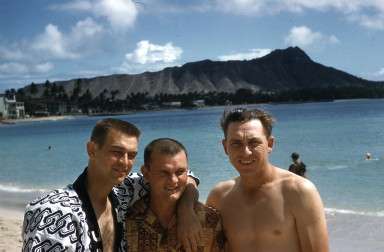
Dodger pitcher Clem Labine (left), infielder Don Zimmer (center) and first baseman Gil Hodges are photographed on Waikiki Beach, Honolulu, Hawaii with Diamond Head in the background. Hawaii was a five-day stop in October, 1956 where the Dodgers played three games, before continuing with their Goodwill Tour to Japan.
Photo by Peter O’Malley. All Rights Reserved.
The Dodger roster included Manager Walter Alston; Coaches Billy Herman, Jake Pitler and Joe Becker; pitchers Carl Erskine, Don Newcombe, Clem Labine, Don Bessent, Roger Craig, Ed Roebuck, Don Drysdale, Ralph Branca and Fred Kipp; catchers Roy Campanella, Herb Olson and Dixie “Homer” Howell; infielders Pee Wee Reese, Don Zimmer, Jackie Robinson, Randy Jackson, Gil Hodges, Jim Gentile, Bob Lillis, Jim Gilliam and Bob Aspromonte; outfielders Duke Snider, Bert Hamric, Don Demeter and Gino Cimoli.
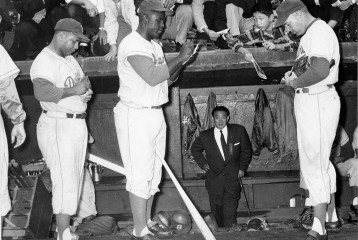
Popular Dodger autograph targets included Roy Campanella, Jackie Robinson and Duke Snider, all in the Baseball Hall of Fame.
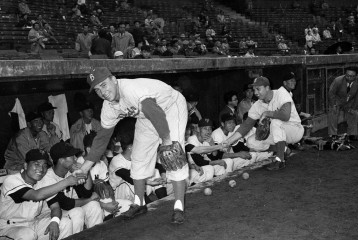
Shortstop Pee Wee Reese and first baseman Gil Hodges visit the opposing dugout and cultivate relationships before a game.
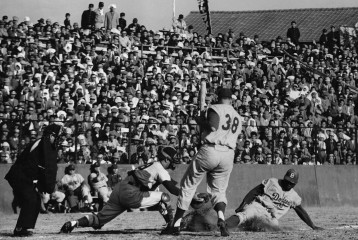
Known for his daring baserunning in the majors, Jackie Robinson slides into home.
Those who didn’t make the trip included pitcher Sandy Koufax, outfielder Carl Furillo, outfielder Sandy Amoros and pitcher Johnny Podres, whose October 26 release from the United States Navy due to a back ailment didn’t give him enough time to get in proper playing condition.
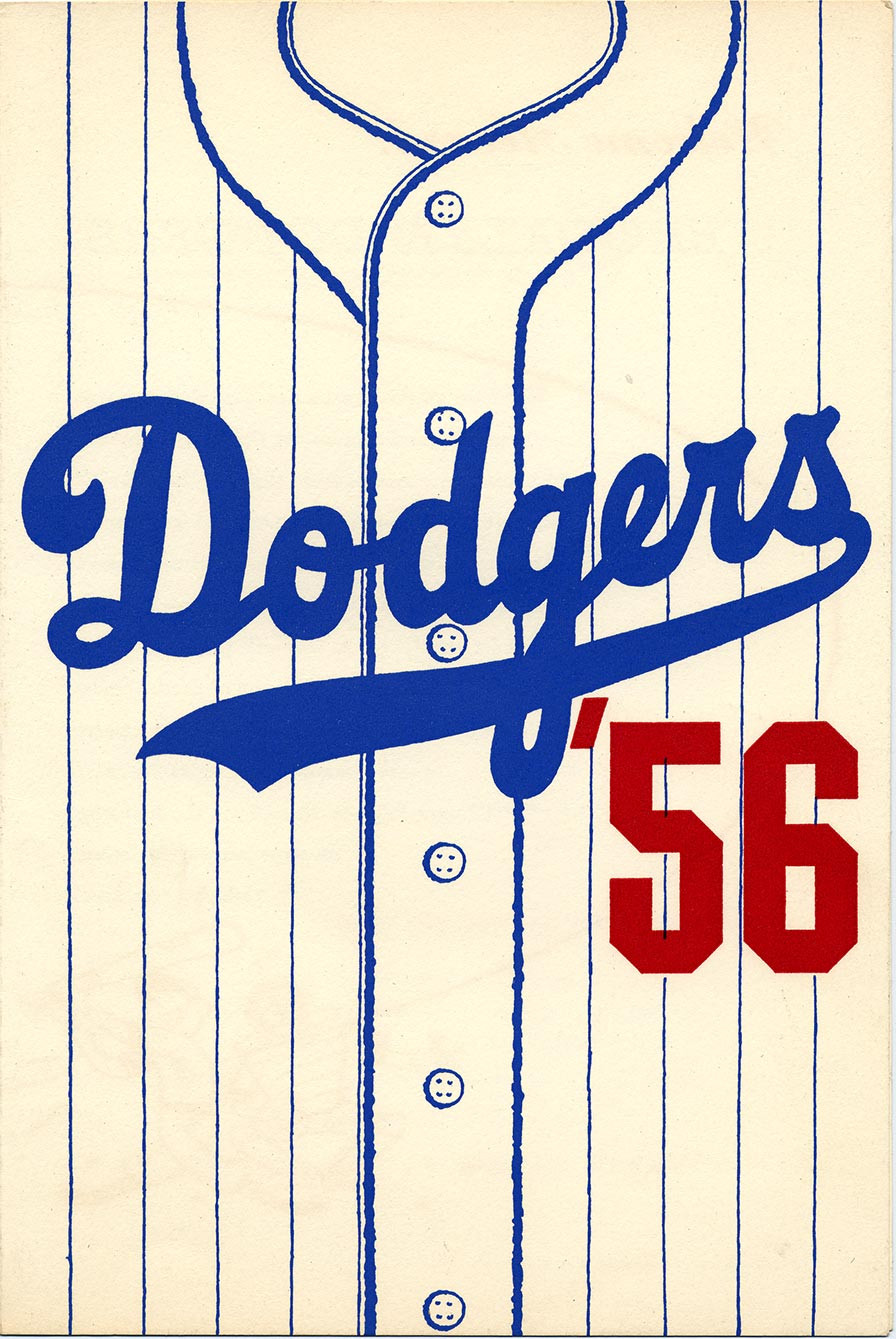
A dinner menu from the Dodgers’ Pan American World Airways flight from Honolulu to Tokyo, en route to the 1956 Goodwill Tour to Japan.
The special Pan American World Airways plane, traveling from Honolulu to Tokyo, was delayed nearly six hours at Wake Island because of mechanical trouble. Americans living on Wake declared a holiday when they learned the Dodgers would be stranded there while repairs were being made. Schools were closed, children flocked to the airport to welcome the Dodgers to their tiny coral atoll. “We had a fine time with the children at the airport,” Campanella said. Asahi Evening News, October 19, 1956
When they finally landed in Japan, the Dodgers — originally scheduled to arrive in Japan at 10 a.m. — received a warm greeting at 3:25 p.m. from thousands of fans cheering in the rain as a motorcade carried the Brooklyn party through the wet Tokyo streets from Haneda Airport to the Imperial Hotel.
Forty actresses from the Daiei Motion Picture Studios, including internationally renowned Machiko Kyo, presented the Dodger players with flowers. “This is really a surprise,” Newcombe said upon receiving his bouquet.
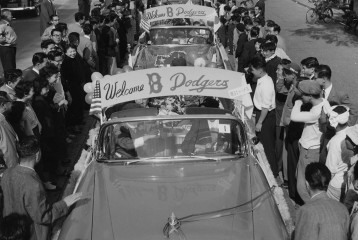
The Dodgers received warm welcomes from fans in the cities and along the countrysides in Japan.
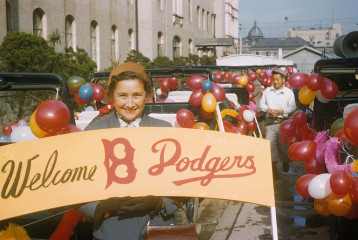
Kay O’Malley rides along the “Welcome Dodgers” motorcade in Japan.
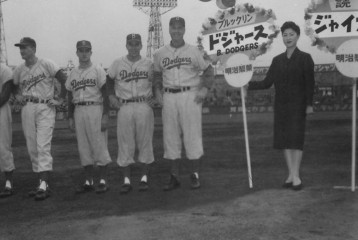
The Brooklyn Dodgers line up during pregame introductions in Japan.
At the airport lobby, center fielder Duke Snider said at a press conference, “We’re all very tired, but we’re glad to be here.” Yomiuri Japan News, October 19, 1956
On its editorial page, The Japan Times previewed the Dodgers’ arrival with an analysis on why the Brooklyn club held a special place in the hearts of Japanese baseball fans.
“The names of the many veteran stars on the Brooklyn roster are already familiar to most Japanese fans, and the Dodgers may rest assured that they are among friends.
“One of the notable achievements of the team from Flatbush Avenue was its success in breaking the color line in organized baseball. It indicated that progress is being made in the United States toward solving the problem of racial prejudice.
“We will be looking forward to many thrilling afternoons of watching baseball at its best — as played by the fabulous Dodgers of Brooklyn.” The Japan Times
There was early praise for the Dodgers, despite a 3-2-1 record in the first six games. Fujio Nakazawa, a leading Japanese baseball commentator, credited Manager Walter Alston’s sportsmanship and willingness to give praise to the Japanese team when it was due.
“Japanese ball players have much to learn from the Dodgers who have not complained about their busy schedule, which started the day after their arrival,” Nakazawa said. “The Dodger players are always cheerful and play hard. A defeat does not discourage them.” United Press International, Asaki News, October 27, 1956
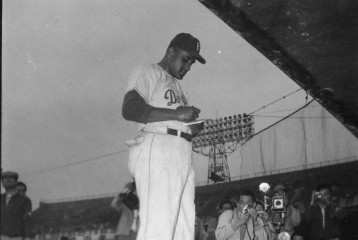
Pitcher Don Newcombe signs autographs prior to a game.
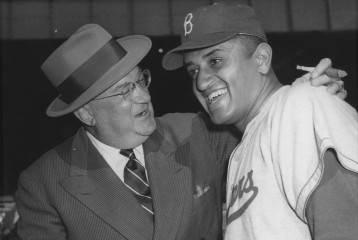
(L-R) Walter O’Malley; Don Newcombe. Dodger President Walter O’Malley congratulates Dodger right hand pitcher on the announcement he is elected by the Baseball Writers’ Association as the first recipient of the Cy Young Award after the 1956 season.
AP Photo/David A. Smith
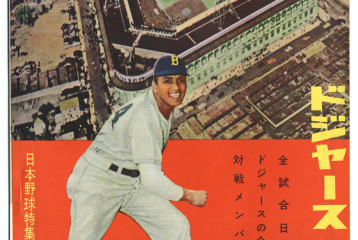
Cover of a 1956 program sold in Japan for an exhibition game between the Brooklyn Dodgers and Japanese Professional teams during the 1956 Dodgers Goodwill Tour. Dodger Cy Young Award-winning pitcher Don Newcombe is on the cover.
Scenes of the Dodgers blending with the local landscape and traditions would fill newspapers and magazines for the next three weeks. The Yomiuri Japan News carried pictures of the Dodger players behind the scenes, at banquets, in the clubhouse and meeting with fans in the dugout and grandstands.
“Idols of Ebbets Field, the champion of the year’s National League pennant race tomorrow are due in the ancient city of Mito to meet the Kanto All-Stars after playing five games in Tokyo, Sapporo and Sendai,” stated the Japan News. “The scores for the visiting Dodgers have been anything but complimentary: They have already lost two of the games. And the fond hopes of winning every game in the course of their sojourn were all but completely shattered. Viewed at close range, though, the Dodger stars as men and players seemed — almost to the last member — to be very likeable fellows, full of goodwill and fun and fine sportsmanship. And even while losing games, they continued to win friends almost everywhere they went and in turn were held in high esteem by enthusiastic local baseball fans.” Yomiuri Japan News, October 25, 1956
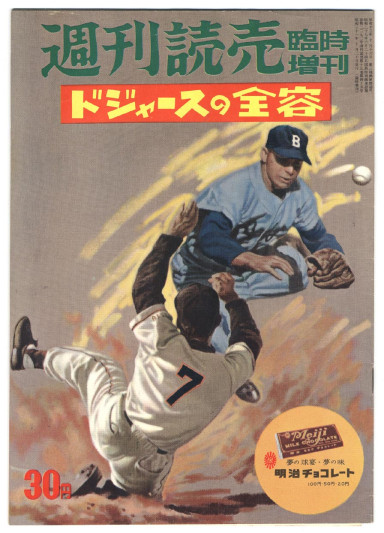
The big headline “Dodgers On And Off The Ball Park” in the American military newspaper The Stars and Stripes featured photos of the many aspects of the tour. In another photo, rookie pitcher Don Drysdale, wearing the happi coat and headband, opened his mouth to receive food from Tsuneo Harada at the reception as Giants pitcher Sho Horiuchi grinned. The Dodger wives, meanwhile, took time away from their husbands to attend a tea ceremony while dressed in traditional kimonos. Don Newcombe signed autographs above the dugout at Korakuen Stadium while Randy Jackson, Drysdale and Roy Campanella enjoyed a rickshaw ride in front of the Imperial Hotel before the start of the first game. The Stars and Stripes, October 23, 1956
There would be countless other stories and footnotes along the way, even a few surprises:
Hall of Fame infielder Jackie Robinson was charged with the first error in Japan when he dropped a bottle of sake entering the Imperial Hotel. O’Malley family friend Bud Holman also needed to shop for a new movie camera after dropping his at Korakuen Stadium. The Japan Times, October 21, 1956
The Dodger players were amazed at the Japanese fans who, in keeping with tradition, threw foul balls back onto the field. The Japan Times, October 21, 1956
The Dodger players changed into their uniforms before leaving their hotel. En route to the ballpark, taxis and trucks constantly trailed the Dodger bus, hoping to get an autograph while all vehicles were in motion. Ibid.
The most popular souvenirs among shoppers in the Dodger party were tax-free cameras, suits, pearls and Japanese dolls. Ibid.
In Osaka, a friendly schoolgirl translated Japanese church services for Carl Erskine and his wife Betty. Later, the Erskines were visited by 10 members of a family named Baba. Although the Babas could not speak English, they got it across that they had a mutual friend in Anderson, IN, Erskine’s hometown. Associated Press, November 15, 1956
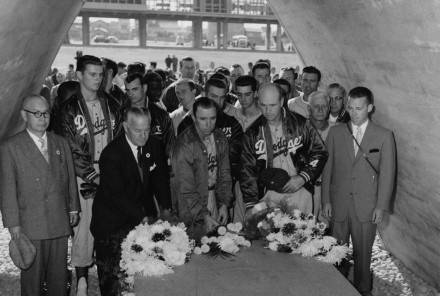
During their 1956 Goodwill Tour to Japan, the Dodgers visit Hiroshima and its memorial. Later that day, the Dodgers dedicate a bronze plaque at the entrance to the new ballpark.
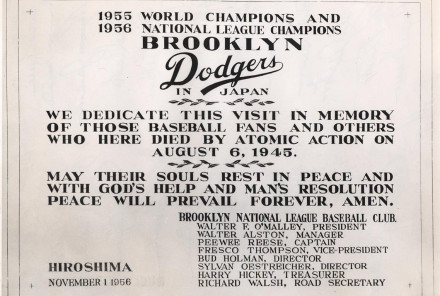
A copy of the bronze plaque that the Dodgers presented to officials for the entrance to the Hiroshima ballpark in Japan, following the team’s emotional visit to the Hiroshima Peace Memorial on November 1, 1956. The Dodgers played an exhibition game in Hiroshima. The original plaque, with wording by Walter O’Malley, has been relocated to a suite at the current Hiroshima ballpark.
The Japanese Travel Bureau outlined a schedule of trips for family members of the party, including sightseeing and shopping trips to Tokyo; a three-day trip to Kamakura and Miyanoshita; an evening performance at the Kabuki Theatre, visits to Mijajima, Hiroshima and Kyoto; an excursion on a shooting boat to the Hozu Rapid; and sightseeing trips to Mikimoto’s Pearl Island and Atami Hot Springs.
Some of the highlights on the field during the Dodgers’ 14-4-1 exhibition record included:
With rookie Jim Gentile at first base, veteran Gil Hodges moved to the outfield and delighted crowds with his pantomime routine in left field. During a 6-3 victory over the All-Japan Stars in Utsonomiya on October 28, Hodges mimicked Roy Campanella’s movements behind home plate, giving signals and moving into a catcher’s crouch. The Stars and Stripes, October 29, 1956
In perhaps the most memorable and poignant moment of the tour, the Dodgers dedicated their November 1 game in Hiroshima to the memory of baseball fans and others who died in the atomic bombing of that city, and to peace. A bronze plaque was placed about the entrance of Hiroshima’s new baseball stadium.
Inscribed were the words, “We dedicate this visit in memory of those baseball fans and others who here died by atomic action on Aug. 6, 1945. May their souls rest in peace and with God’s help and man’s resolution peace will prevail forever, amen.” The plaque bore the names of O’Malley, Alston, Reese and other club officials.
On November 4, National League umpire Jocko Conlan was overruled in his attempts to call the exhibition game in Osaka because of darkness and a light drizzle. The 40,000 fans sat tight, occasionally yelling “Yaro” (Play ball!).
After 20 minutes of talk between the Dodgers and Japanese officials, the game was resumed. Japanese officials later said Koshien Stadium, Japan’s largest, is never used at night after September 30 and the price of electricity restored would be prohibitive. They would have to pay a full month’s power bill for a few minutes’ use.
“At that point the Japanese officials told us we had to keep playing because the fans weren’t going home if they had to sit all night,” third baseman Jackie Robinson said. Asahi Evening News, November 6, 1956
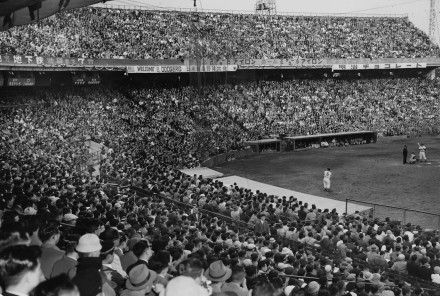
The Brooklyn Dodgers drew overflow crowds throughout their 1956 Japan tour.
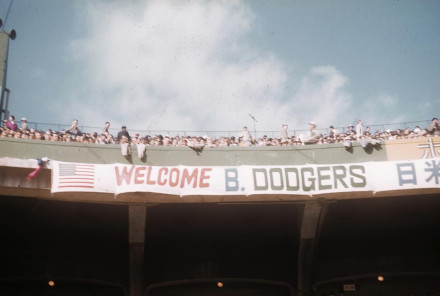
The Dodgers began their tour with a 3-2-1 record in their first six games.
More than 450,000 fans would attend the 19 exhibition games, an average of almost 24,000 per game. The Dodgers returned to Tokyo on November 15 with tales of endless parades in the larger cities where laborers and clerks poured into the street to clasp the visitors’ hands.
Vice President Fresco Thompson said on November 5 that Brooklyn might invite two Japanese players to the United States to attend the Dodgers’ spring training. Thompson said it wouldn’t necessarily mean the Dodgers were interested in signing the players, standing pat on previous statements that the ballclub didn’t come to Japan to sign its players.
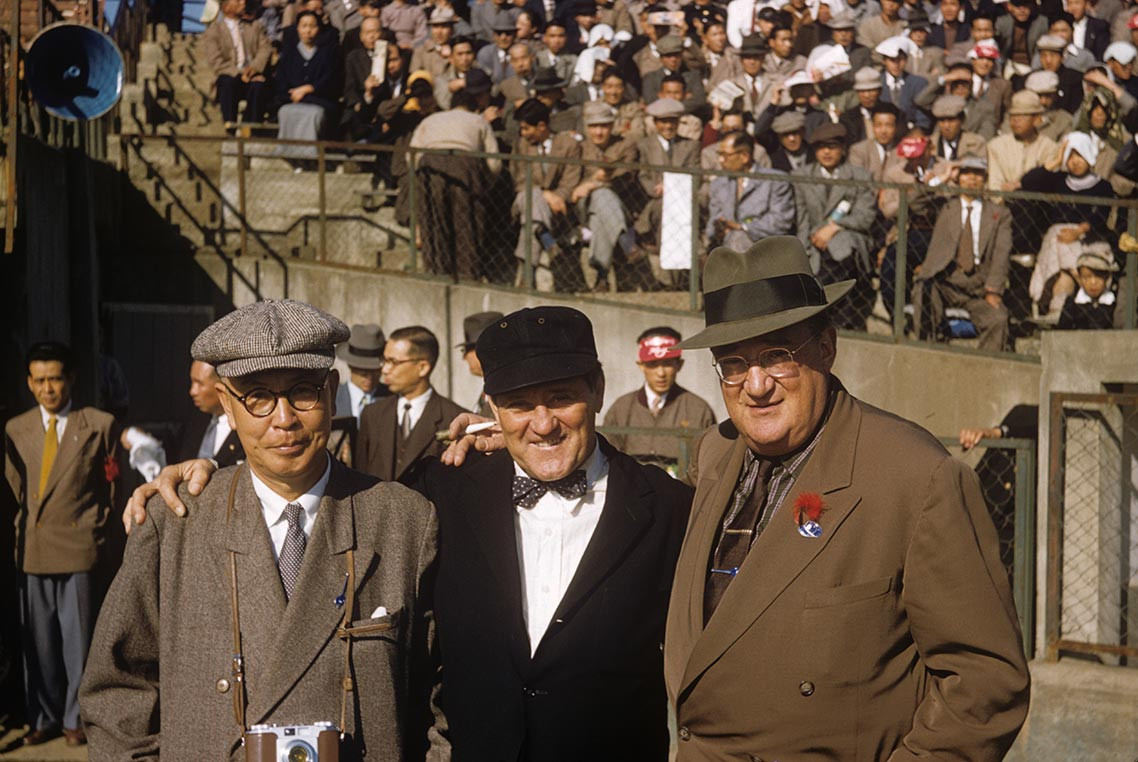
Yomiuri sports columnist Sotaro Suzuki, Hall of Fame umpire Jocko Conlan, and Dodger President Walter O’Malley during 1956 Dodgers Goodwill Tour of Japan.
“But we are looking for a way to repay all of the goodwill we have experienced in Japan,” Thompson said, “and I think it might benefit Japanese baseball if some players could attend our training camp, where we stress fundamentals instead of conditioning, as they do here.”
The Dodgers followed through with an invitation for Suzuki to bring Yomiuri Giants Manager Shigeru Mizuhara to Dodgertown in Vero Beach, FL for spring training in 1957 along with his top battery, catcher Shigeru Fujio and pitcher Sho Horiuchi. The Giants’ group was amazed to see six training fields and more amenities for both training and recreational purposes on the 110-acre facility.
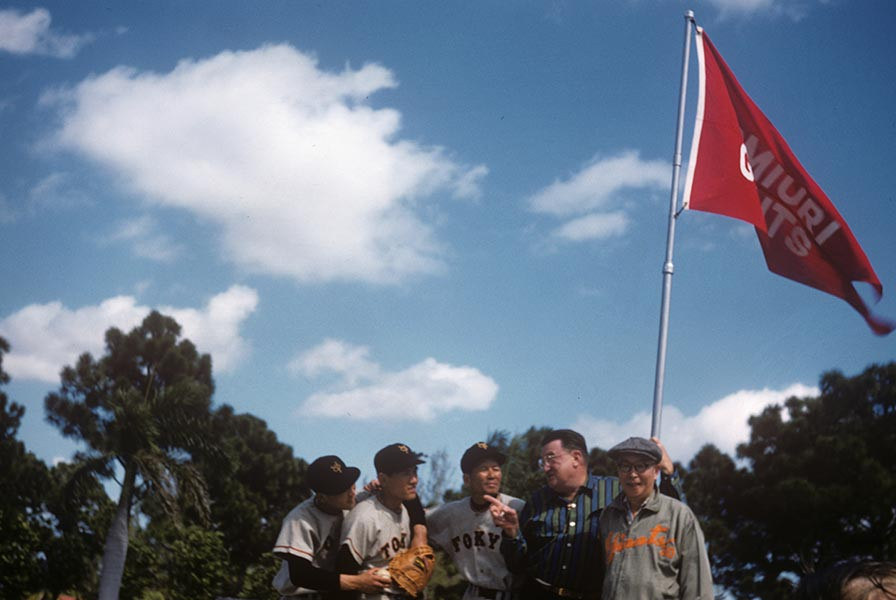
(L-R): Tokyo Yomiuri Giants catcher Shigeru Fujio; Yomiuri Giants pitcher Sho Horiuchi; Yomiuri Giants Manager Shigeru Mizuhara; Dodger President Walter O’Malley; Japan Baseball Hall of Fame columnist Sotaro Suzuki. Mizuhara was inducted into the Japan Baseball Hall of Fame in 1965 and Suzuki in 1968. At Holman Stadium, Dodgertown, Vero Beach, Florida, March, 1957. The pennant welcomes the representatives of Yomiuri to Dodgertown.
“While our stay in Vero Beach is rather short, we are learning many, many things, not only in baseball with respect to the real feelings of the American people toward the Japanese people,” Suzuki wrote. “I think this is the great merit of baseball, through which I am sure we will create a better understanding and friendship between the two baseball-loving nations of the United States and Japan.”

